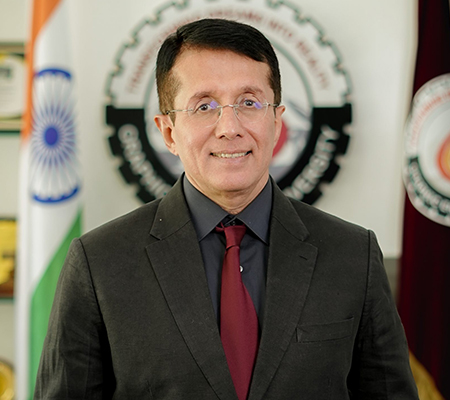“At GEHU, we deliver world-class education while shaping our students into skilled professionals and excellent leaders. By embracing AI-driven learning, fostering adaptability and equipping students with future-ready skills, we prepare them to excel in a rapidly evolving world.”
Vice Chancellor, Graphic Era Hill University

Graphic Era Hill University (GEHU) stands as a beacon of academic excellence, driven by the visionary leadership of our Founder, Prof. (Dr.) Kamal Ghanshala, and a relentless pursuit of knowledge, innovation and holistic development. At GEHU, we take pride in nurturing value-driven individuals, competent professionals, and future leaders. Our commitment to excellence is reflected in our world-class infrastructure, industry-aligned curriculum and emphasis on research, artificial intelligence, and technological innovation. Through strategic collaborations with global industry leaders like IBM, Adobe, Infosys and Capgemini, along with academic exchanges with prestigious institutions worldwide, we equip our students with unparalleled global exposure. With AI-driven learning methodologies and state-of-the-art labs, we empower students to harness the potential of emerging technologies. The university fosters an inclusive, diverse and vibrant learning environment where students are encouraged to think innovatively, challenge norms, and develop leadership and teamwork skills. Our graduates consistently achieve remarkable success, securing positions in top corporations such as Apple, Microsoft, Google, Amazon and Tata Technologies, reinforcing our reputation as a premier institution.
At GEHU, education is more than just academics—it’s about shaping character, building resilience and inspiring dreams. We are deeply committed to instilling ethical values, social responsibility and a strong Indian ethos in our students, preparing them to make a meaningful impact on society. With AI integration in curriculum design, smart learning analytics and hands-on projects in machine learning and automation, we ensure that our students stay ahead in an evolving digital world. Our “question-by-example” approach to learning cultivates curiosity, adaptability and self-improvement, ensuring our students excel not just in their careers but also as responsible global citizens. With a thriving alumni network and an ever-growing legacy of excellence, we continue to evolve, driven by our mission to empower students with knowledge, skills and values. The future is bright, and we look forward to shaping it together—one success story at a time.
PhD (EE) in Semiconductor Quantum Devices, North Carolina State University USA (1991-1995)
MS(EE) in Computer Architecture, Duke University, USA (1989- 1990)
BE in Electrical Engineering, M. S. University of Baroda (1981 – 1985)
[ Includes some of the important papers and important invited talks. MTech & BTech Student authored papers not included. Work done while in industry and consultancy projects not cited, talks given for FDP in various institutes of India not cited.]